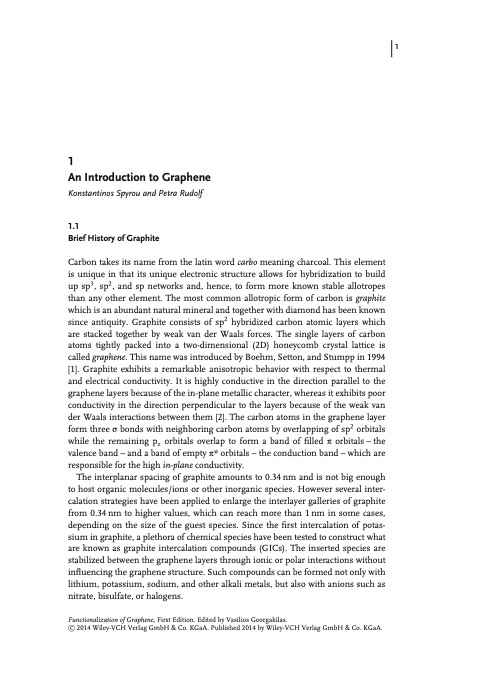
PDF Publication Title:
Text from PDF Page: 001
1 An Introduction to Graphene Konstantinos Spyrou and Petra Rudolf 1.1 Brief History of Graphite Carbon takes its name from the latin word carbo meaning charcoal. This element is unique in that its unique electronic structure allows for hybridization to build up sp3, sp2, and sp networks and, hence, to form more known stable allotropes than any other element. The most common allotropic form of carbon is graphite which is an abundant natural mineral and together with diamond has been known since antiquity. Graphite consists of sp2 hybridized carbon atomic layers which are stacked together by weak van der Waals forces. The single layers of carbon atoms tightly packed into a two-dimensional (2D) honeycomb crystal lattice is called graphene. This name was introduced by Boehm, Setton, and Stumpp in 1994 [1]. Graphite exhibits a remarkable anisotropic behavior with respect to thermal and electrical conductivity. It is highly conductive in the direction parallel to the graphene layers because of the in-plane metallic character, whereas it exhibits poor conductivity in the direction perpendicular to the layers because of the weak van der Waals interactions between them [2]. The carbon atoms in the graphene layer form three σ bonds with neighboring carbon atoms by overlapping of sp2 orbitals while the remaining pz orbitals overlap to form a band of filled π orbitals – the valence band – and a band of empty π* orbitals – the conduction band – which are responsible for the high in-plane conductivity. The interplanar spacing of graphite amounts to 0.34 nm and is not big enough to host organic molecules/ions or other inorganic species. However several inter- calation strategies have been applied to enlarge the interlayer galleries of graphite from 0.34 nm to higher values, which can reach more than 1 nm in some cases, depending on the size of the guest species. Since the first intercalation of potas- sium in graphite, a plethora of chemical species have been tested to construct what are known as graphite intercalation compounds (GICs). The inserted species are stabilized between the graphene layers through ionic or polar interactions without influencing the graphene structure. Such compounds can be formed not only with lithium, potassium, sodium, and other alkali metals, but also with anions such as nitrate, bisulfate, or halogens. Functionalization of Graphene, First Edition. Edited by Vasilios Georgakilas. ⃝c 2014 Wiley-VCH Verlag GmbH & Co. KGaA. Published 2014 by Wiley-VCH Verlag GmbH & Co. KGaA. 1PDF Image | An Introduction to Graphene

PDF Search Title:
An Introduction to GrapheneOriginal File Name Searched:
352733551X-c01.pdfDIY PDF Search: Google It | Yahoo | Bing
Salgenx Redox Flow Battery Technology: Power up your energy storage game with Salgenx Salt Water Battery. With its advanced technology, the flow battery provides reliable, scalable, and sustainable energy storage for utility-scale projects. Upgrade to a Salgenx flow battery today and take control of your energy future.
| CONTACT TEL: 608-238-6001 Email: greg@infinityturbine.com | RSS | AMP |